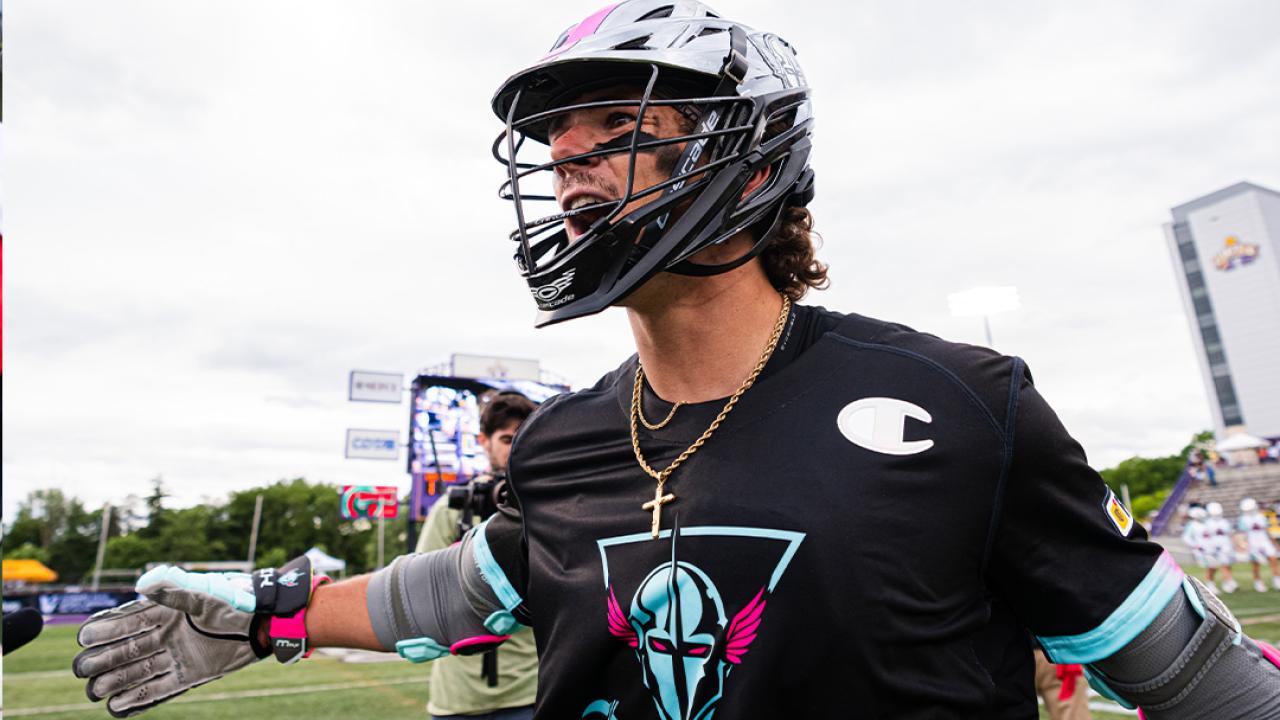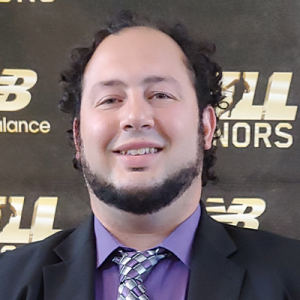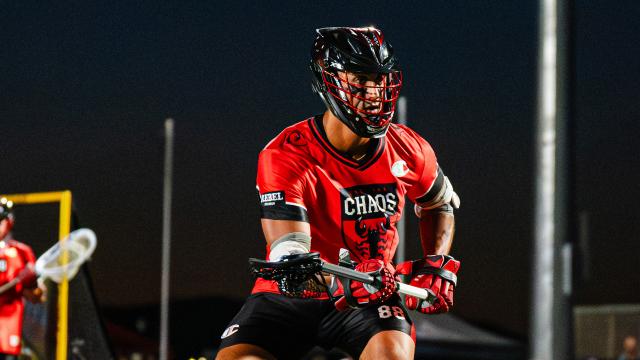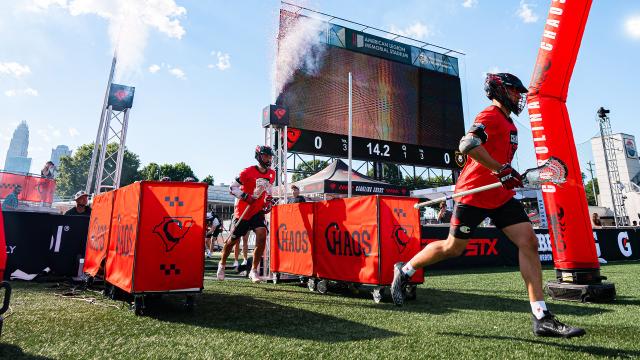
Cross Ferrara the Latest Flagbearer for Division III Lacrosse in the Pros
“I’d call a timeout here,” ESPN’s Ryan Boyle said as Chrome midfielder Sam Handley’s shot went wide and out of bounds with 10.6 seconds remaining in the team’s season opener against the Whipsnakes.
“I would agree with you, ‘cause you don’t want Cross Ferrara making this last play,” analyst Paul Carcaterra responded.
Ferrara, a rookie fourth-round pick out of Salisbury, who — in a move that surprised a number of people — earned a starting role for the first game of the season. He picked up the ball for the restart from the bottom right wing. Taking on Ty Warner, one of the top short-stick defensive midfielders in the game, Ferrara dodged and got a step on him. Ferrara got about 10 yards up the field before turning the corner and releasing a shot that blew past Whipsnakes goalie Kyle Bernlohr with 4.7 seconds left.
“Eat your words, Carc!” Cotter exclaimed as the Albany crowd roared.
Scoring the game-winning goal in his professional debut is not something Ferrara ever dreamed about. He never really thought playing professionally was an option. He wasn’t even sure he wanted to play lacrosse in college.
The family construction business could wait, though. Ferrara loved Salisbury and head coach Jim Berkman, who then helped convince him to play professionally, despite Ferrara’s belief that not many players from Division III ever made it.
“If you get a chance, take it,” Ferrara said about Berkman’s advice. “If you get the opportunity, you don’t want to pass this up.”
Chrome head coach Tim Soudan wasn’t always 100-percent certain about Ferrara’s route to the pros, either. His son, Tanner, transferred from UMass-Lowell to Salisbury, and he went to watch many of the games.
At the team’s Maroon and Gold game, he noticed Ferrara and how he ran by all of the starting defensemen. He was listed at attack but running out of the midfield, another point that intrigued Soudan.
As the season went on, he noted how Ferrara scored in a bevy of ways. Soudan wasn’t entirely sure his shot would translate into the pros, but his speed was elite. He had an “unshakeable” attitude and made big plays in big moments. Soudan wanted to take a chance on him, but he was also going to have to sell the idea to his assistant coaches.
It was a talk with one of his captains, Division III product Jordan MacIntosh, that helped seal the deal.
“One thing [Soudan] had always proven in his long tenure in the MLL is he’s got a good eye for talent,” MacIntosh said. “He’s always found players that went to big schools and played in national championships, Final Fours in Division I, but he’s also done a good job finding those diamonds in the rough.
“We were talking around the draft. He had mentioned he was looking at a couple kids. I said, ‘Trust your gut on this stuff. You’ve had good luck.’ I reminded him without him giving me that opportunity in 2011, 2012, I’m not here 12 years later playing professional field lacrosse.”
It’s not a surprise that most of the talent in the Premier Lacrosse League played Division I. In 2023, Ferrara was the only Division III athlete drafted. The same goes for 2022 (Max Wayne, round three to the Atlas), while there were zero players from Division III selected in 2019, 2020 or 2021.
There is a path, however, for Division III players to not only play professional lacrosse but make an impact. Twelve players from Division III made 25-man rosters for their respective teams: Wayne (Christopher Newport) and Kyle Hartzell (Salisbury) for the Cannons; Chase Fraser (Neumann) and Jerry Ragonese (RIT) for the Chaos; Ferrara, MacIntosh (RIT) and Eli Salama (RIT) for the Chrome; Ryan Lee (RIT) and Ryan Kennedy (York) for the Redwoods; and Matt Whitcher (York), Eli Gobrecht (Ithaca) and Matthew Hossack (RIT) for the Waterdogs.
Hartzell is the oldest player in the league and has seven professional field lacrosse All-Star appearances to his credit. MacIntosh has made two All-Star appearances, while Gobrecht has earned one. Salama and Fraser play key roles for their respective teams, and the Redwoods are eagerly waiting to include Lee in their lineup after his long playoff run in the NLL with the Colorado Mammoth.
Major League Lacrosse had plenty of players from Division III make an impact, too. Mike Stone (Middlebury) was a two-time All-Star whose strong dodging helped the Boston Cannons win the championship in 2011, while John Uppgren (Tufts) scored five goals in Boston’s 13-10 MLL championship game victory in the league’s final season in 2020. Mike Simon (Stevenson) was also an All-Star, as was John Ortolani (Endicott) and Eric Martin (Salisbury), while players like Eric Hagerty (Endicott), Matt Casey (Ithaca) and Justin Smith (Salisbury) all played roles for their respective teams for multiple seasons.
Stephen Berger might be one of the most recognizable Division III pros. He was a three-time All-American and shared the Division III Midfielder of the Year award his senior year at Washington College. The Long Island Lizards selected him with the final pick in the 2004 MLL Collegiate Draft. He would go on to play 10 years in the league, scoring a total of 218 goals and adding 77 assists. He scored 14 goals in five career playoff games and was selected to the 2008 All-Star Game.
Berger said when he was choosing schools, he was late in the process, and he was also just happy to get the opportunity to continue playing for four more years. He thought there was an advantage Division III players had going into the pros, where teams practice once a week the night before a game, that Division I players might not have.
“There’s not a coach breathing down your back six days a week, 170 days you’re at the school,” he said. “D-III, there’s a lot that’s driven on your own, and so, I think there’s work ethic there that’s unparalleled to a degree. I’m not saying there isn’t any work ethic in D-I, but it’s a lot easier to work your [butt] off when someone’s taking your name at a door, and someone is counting your reps all the time.”
Berger remembers feeling particularly starstruck during the playoffs of his rookie season. The Lizards played the Cannons in the semifinals. Berger had moved from his midfield line with Jay Jalbert and A.J. Haugen to the role of starting attackman alongside Chris Massey and Tim Goettelmann. The Lizards defense featured Nicky Polanco as well as Greg Cattrano in goal.
Opposing Berger were John Christmas, Kevin Leveille, Conor Gill and Mark Millon, whose camp Berger remembered going to when he was younger.
Alongside all of the Division I All-Americans, Berger had the biggest night, leading all players in goals (five) and points (six).
“How much are you willing to work to keep wanting to get better?” he said. “I don’t want to be a D-III guy in this league for a year. I know I said that to my dad. I said, ‘I’m not just going into this thing to do it for a year or just to get drafted.’ There’s a mentality that this wasn’t just going to be like a part-time job.”
MacIntosh had a similar experience, though unlike Ferrara and Berger, he went undrafted. An Oakville, Ontario, native, he knew a few people running the Nationals, who were in Toronto at the time. It wasn’t uncommon for MLL teams to take flyers on local players and add them to the practice squad, essentially guaranteeing a body for the week’s practice because they were already in town while providing game-day insurance in case another player had travel issues.
While he never played for the Nationals, he said it helped get his name swirling around league circles. He was signed by the Rattlers, started his first game against the Ohio Machine, and scored 23 goals in 12 games.
With the PLL’s touring model, having players in-market is not necessary. MacIntosh said that’s made it even harder to crack a lineup. On the other hand, MacIntosh said PLL teams are developing unique playing styles and philosophies, so players that don’t get drafted should look at what playing style they naturally fit with.
While the PLL may not have practice squads dependent on local players, there is a longer training camp that provides players more opportunities to showcase their abilities.
“In the MLL, [training camp] was maybe one weekend, but there was so much overlap that the NLL guys like myself or the college guys were coming in the third week or fourth week in the season,” MacIntosh said. “Now, that’s almost done. There’s a weeklong training camp in the PLL. Guys are there from Friday to the following Sunday. There’s a ton of opportunity to put your best foot forward on the field coming off a college season here you should be in great shape.”
Because Salisbury played in the NCAA Division III championship game, Ferrara arrived late to training camp. When he got to Albany, the Chrome used him at both attack and midfield.
MacIntosh and Berger both mentioned fortune being in their favor as part of the reason they earned professional opportunities, and the same happened for Ferrara. According to Soudan, Chrome attackman Dylan Molloy was attending a wedding and was going to come back on Sunday for the game. Soudan said he didn’t think that would be the most competitive option. And with Molloy, Jackson Morrill and Logan Wisnauskus ready to go and eventual returns from Brendan Nichtern, Jack Myers and Jesse King, if he didn’t play Ferrara in Week 1, he didn’t know if he would ever get an opportunity.
The game-winning goal was Ferrara’s second of the day. He also had two assists. It was a debut that made Soudan proud.
“I found something,” he said. “There’s a lot of rookies that played but didn’t go two-and-two and played at a higher level than he did but probably not with the success he had. He’s a special individual on and off the field.”
It wasn’t just Soudan who was proud, either. MacIntosh and Berger were both excited to see Ferrara succeed and be the latest flagbearer for Division III.
For Ferrara, it still is surreal, but he was able to pinpoint one key for Division III hopefuls: hard work.
“You definitely have got to work a little harder than the guys from D-I,” he said. “You’re not under a spotlight like those guys are, so you’ve got to make a name for yourself and hold onto it. Coming from D-III, it’s few and far between. I never expected for it to happen.”
Phil Shore
Phil Shore has covered lacrosse for a variety of publications. He played Division III lacrosse at Emerson College and is the current head coach at Osbourn Park High School in Virginia. His first book, Major League Life, was published in June 2020. Shore has contributed to USA Lacrosse Magazine since 2011.

Categories
Related Articles




